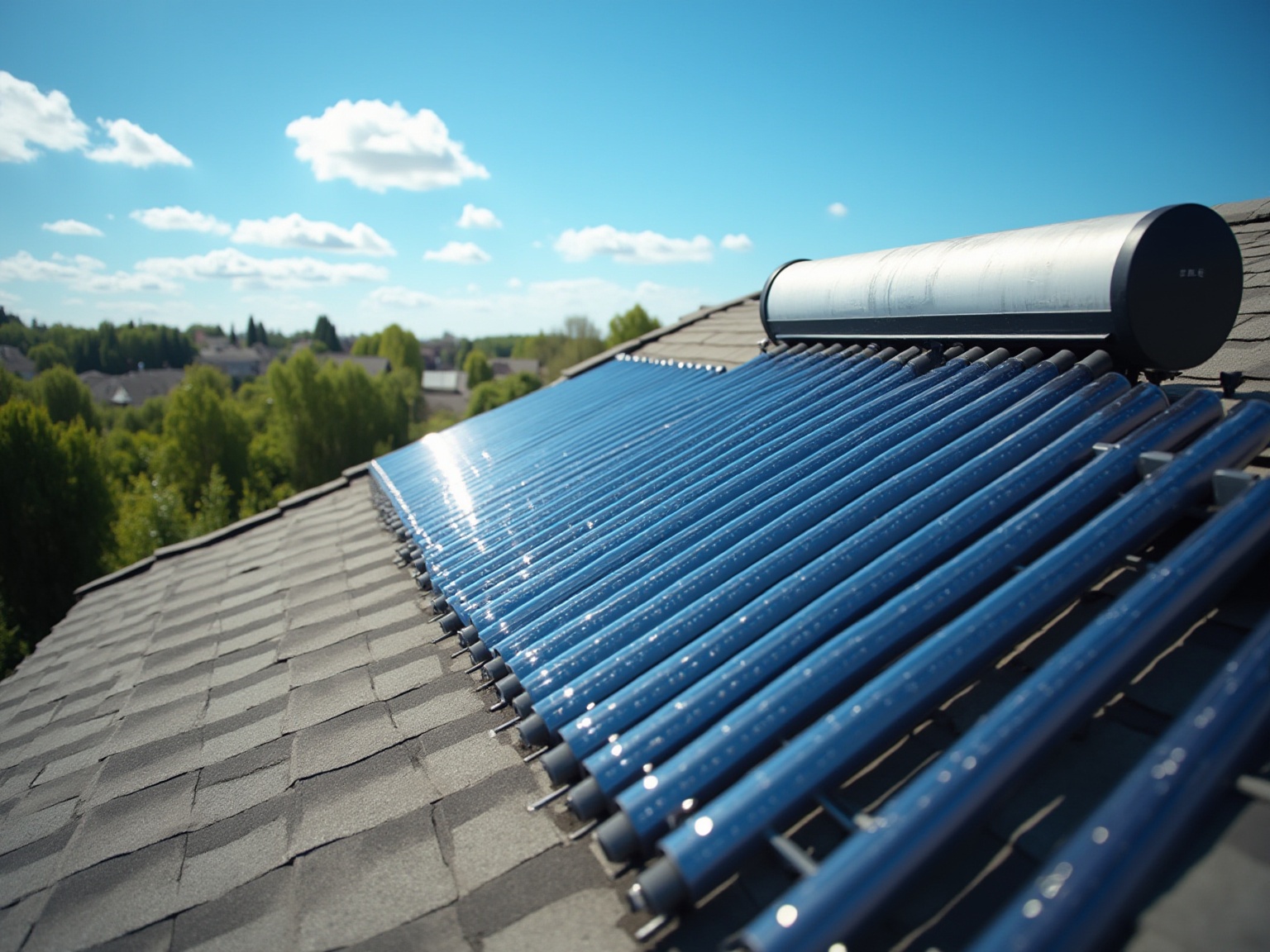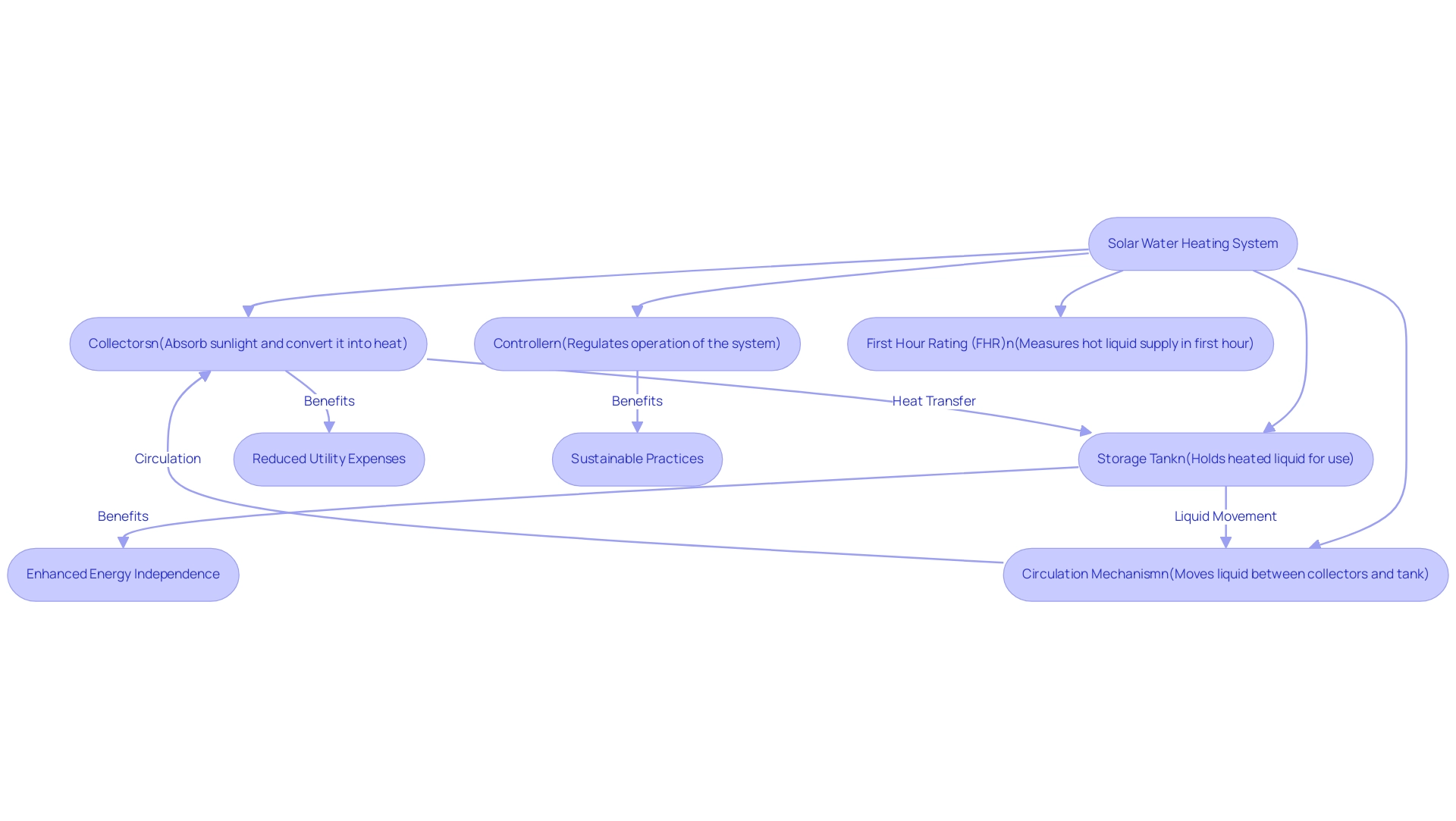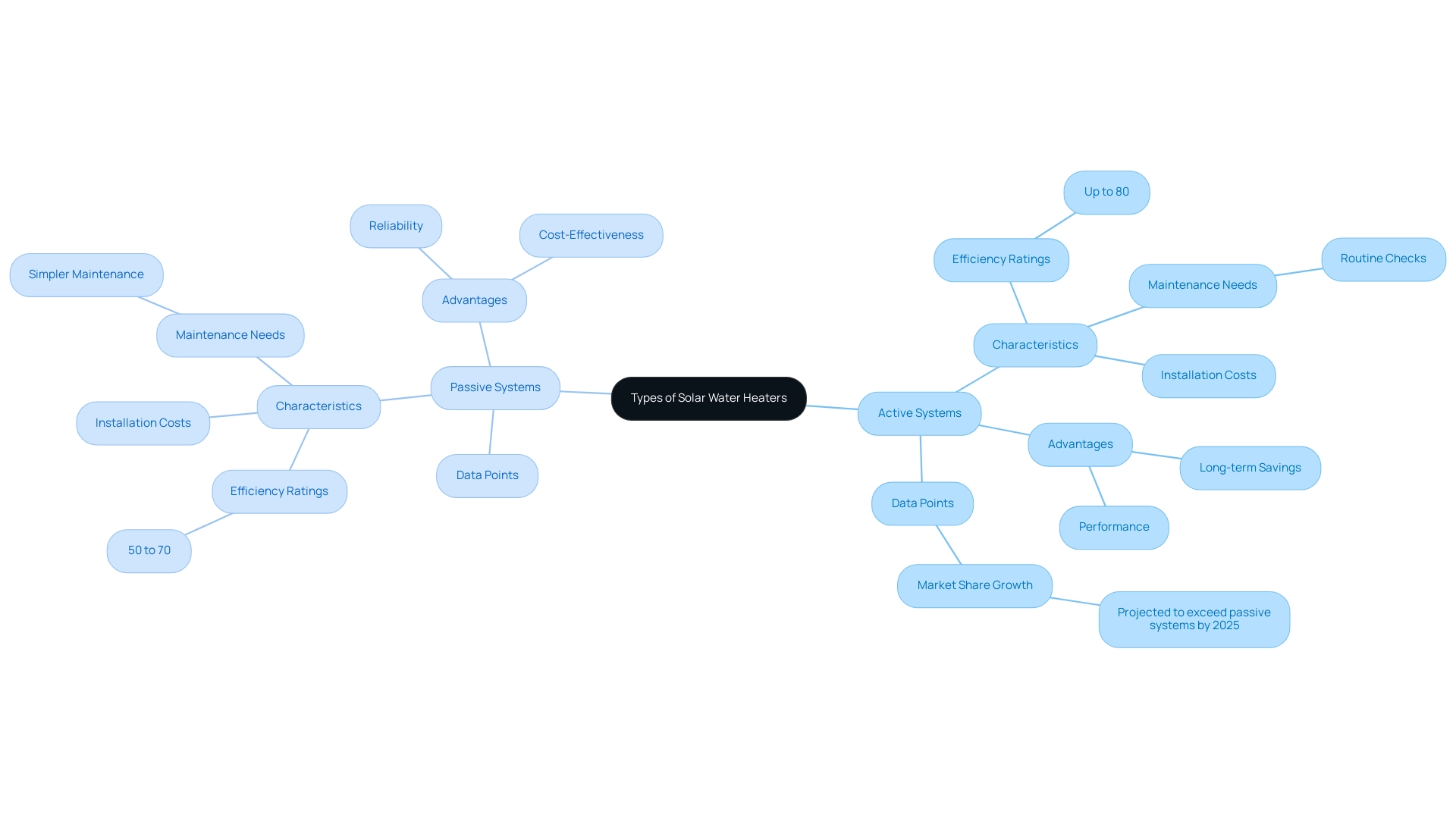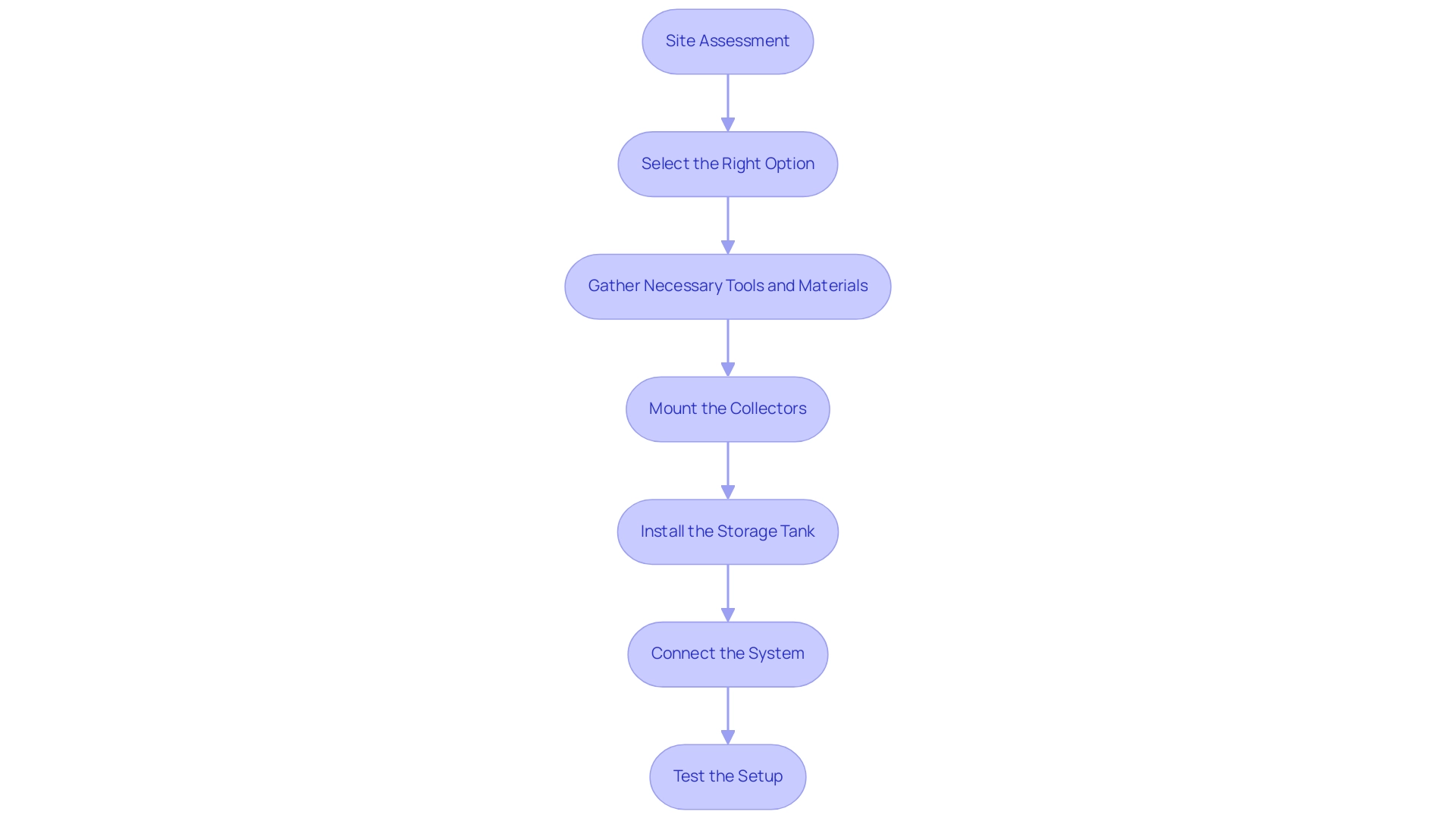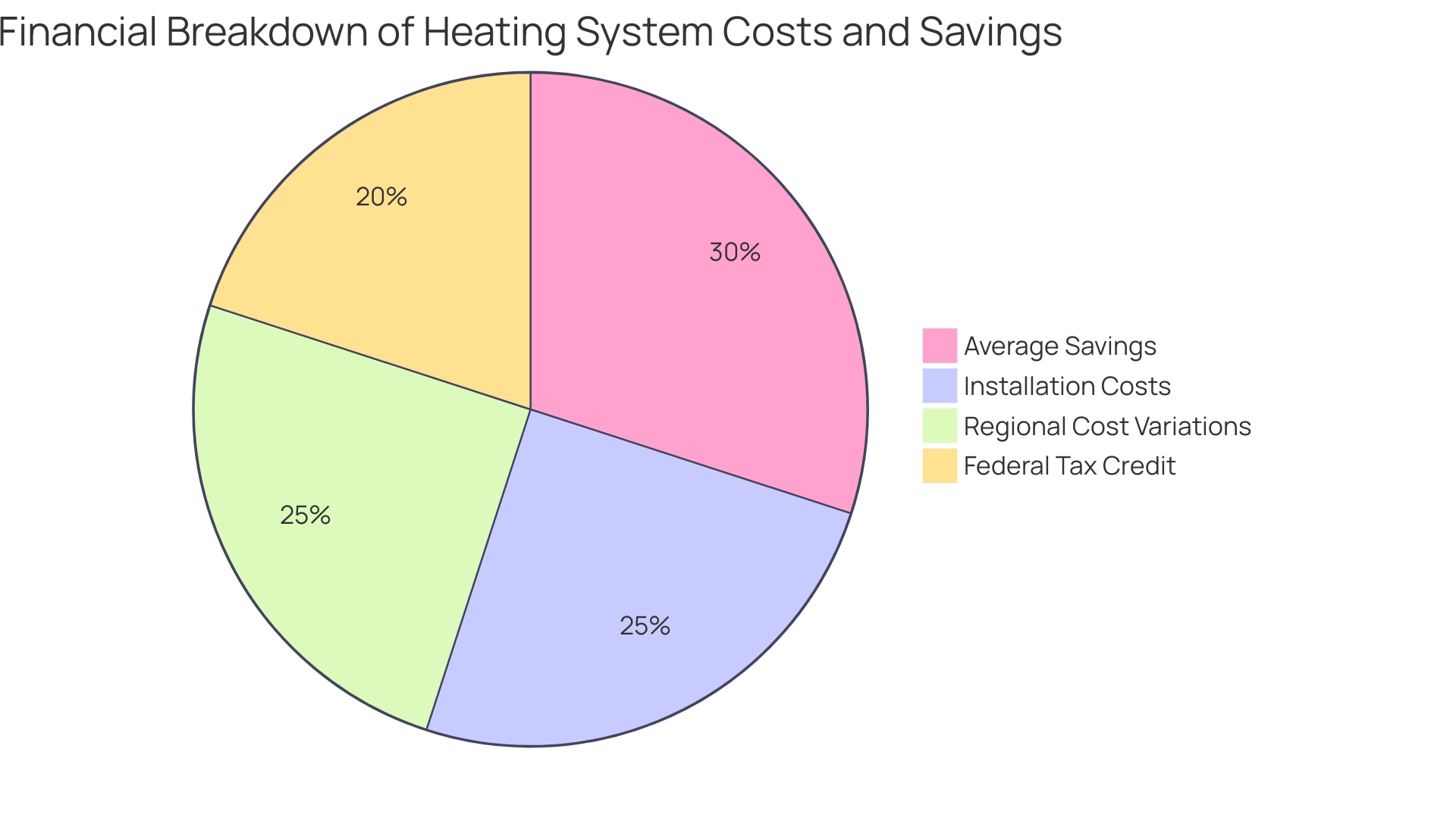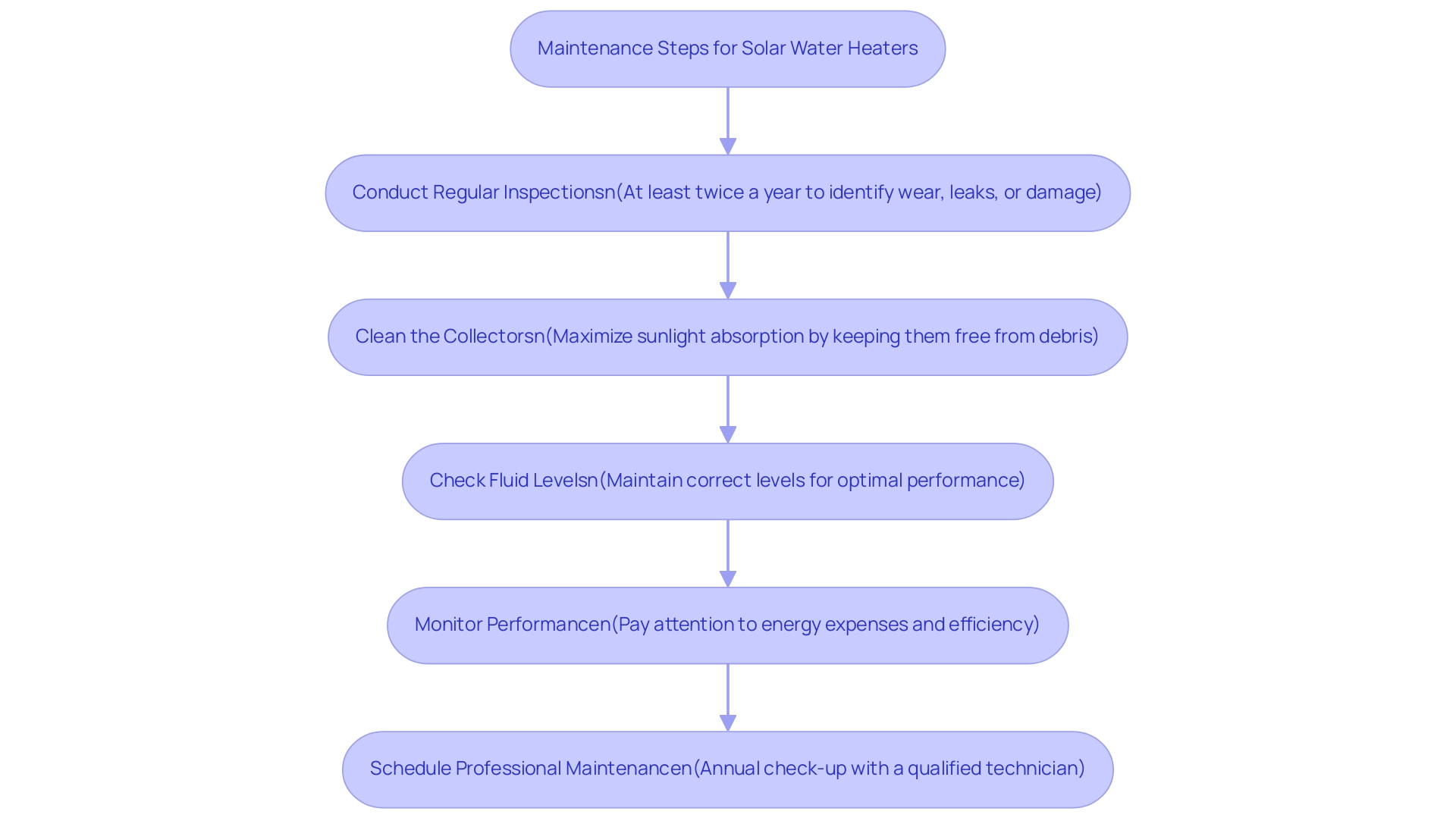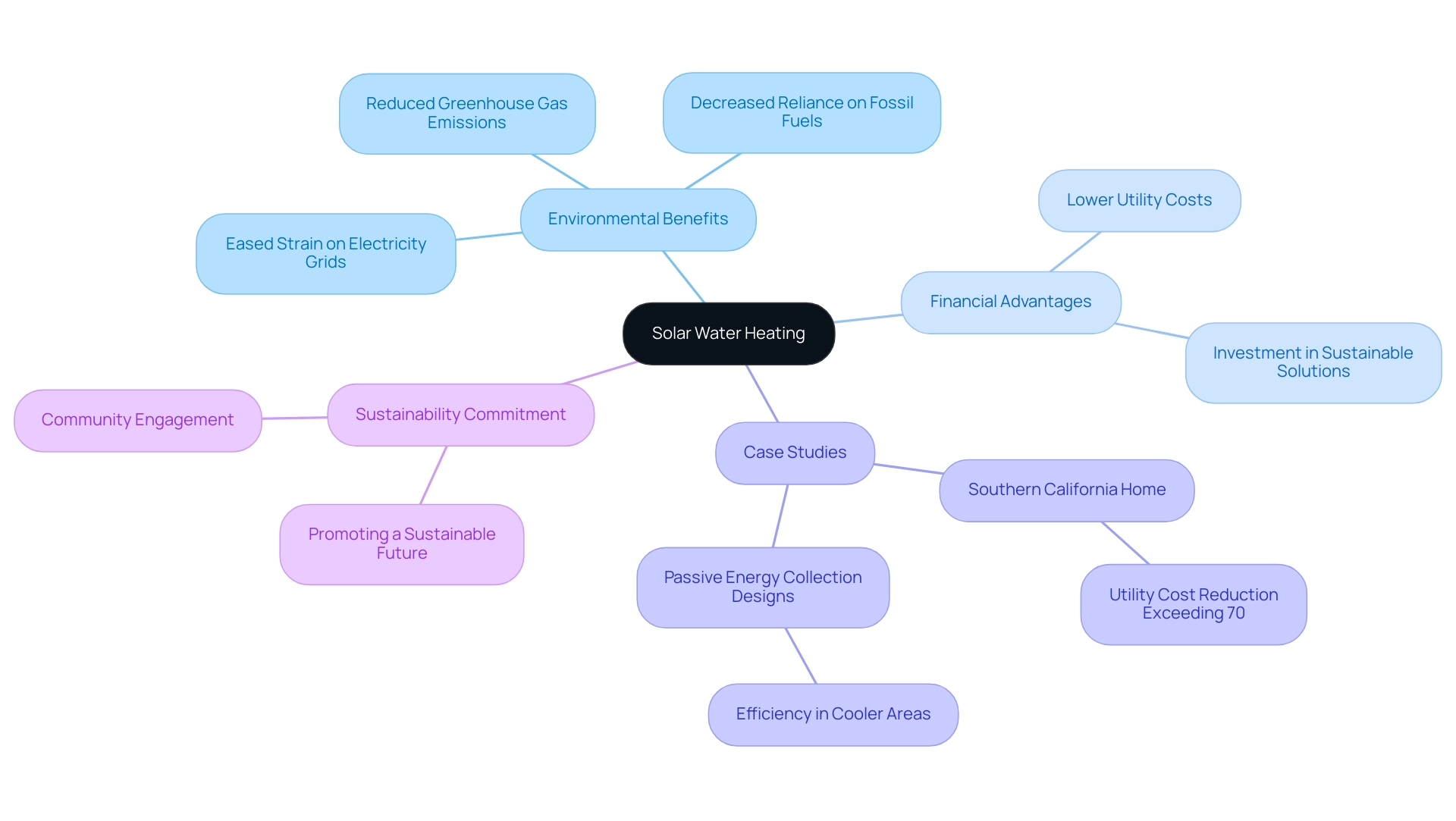Overview
In today’s world, many homeowners are understandably concerned about rising energy bills and the impact of their choices on the environment. This article offers a caring guide on how to choose and install solar panels for hot water systems, emphasizing the significant benefits of solar heating installations. By embracing solar energy, you can not only reduce your energy costs but also contribute to a healthier planet.
We explore how to assess your site conditions, helping you determine the best fit for your home. You’ll learn about the differences between active and passive systems, making it easier to select the right option for your needs. Additionally, understanding the financial incentives available can empower you to make informed choices that lead to substantial long-term savings.
Together, we can work towards a more sustainable lifestyle. Informed decisions about solar energy can pave the way for energy independence, allowing you to take control of your energy usage and costs. It’s common to feel overwhelmed by the choices available, but rest assured, this guide is here to support you every step of the way.
By choosing solar, you’re not just making a smart financial decision; you’re also contributing to a brighter future for our planet. Let’s take this journey together towards a more sustainable and cost-effective way of living.
Introduction
As we increasingly turn our gaze towards renewable energy, many homeowners are understandably concerned about rising energy bills and the need for sustainable solutions. Solar water heating systems emerge as a powerful ally, offering an eco-friendly alternative that harnesses the sun’s abundant energy to heat water. This not only helps reduce reliance on traditional energy sources but also leads to significant savings on utility bills, all while contributing to a smaller carbon footprint.
With advancements in technology making these systems more efficient and accessible, it’s clear that the appeal of solar water heating is undeniable. We understand that making the switch can feel daunting, but this article delves into the workings of solar water heaters, explores the differences between active and passive systems, and provides a comprehensive guide for installation and maintenance.
Additionally, we’ll highlight the financial incentives available to homeowners, underscoring the positive environmental impact of embracing solar energy solutions. Together, we can navigate this journey towards sustainability, as understanding the benefits of solar water heating systems is not just beneficial—it’s essential for a brighter future.
Understanding Solar Water Heating Systems
Are you feeling overwhelmed by rising energy bills? Solar heating installations offer a nurturing solution that not only addresses your concerns but also helps you embrace a more sustainable lifestyle. By utilizing solar panels for hot water systems, you can harness the sun’s energy to warm water in your home, significantly reducing your reliance on traditional power sources. This shift not only leads to lower utility expenses but also contributes to a smaller carbon footprint, allowing you to feel good about your impact on the environment.
The beauty of solar panels for hot water systems lies in their simplicity. Sunlight is captured by collectors, which then transfer heat to the liquid flowing through the system. This efficient method not only heats water effectively but also promotes resource conservation and environmental sustainability.
Key components of these setups include:
- Collectors: Devices that absorb sunlight and convert it into heat.
- Storage Tank: A reservoir that holds the heated liquid generated by solar panels for hot water systems for use when needed.
- Circulation Mechanism: A system that moves liquid between the collectors and the storage tank.
- Controller: An automated device that regulates the operation of the heating arrangement.
- First Hour Rating (FHR): An important performance metric that measures the amount of hot liquid a heater can supply in the first hour of use.
Recent advancements in heating technology have made solar panels for hot water systems more efficient and affordable, making them an accessible choice for eco-conscious homeowners. In California, the adoption of these renewable heating solutions has been on the rise, reflecting a growing interest in sustainable energy. By 2025, the state is projected to see a significant increase in installations, driven by both environmental awareness and financial incentives.
Consider the successful applications of water heating technologies in California. For instance, a case study from the San Joaquin Valley showed how integrating thermal technologies with current agricultural practices not only resulted in resource savings but also encouraged sustainable land use. This collaboration between renewable energy development and agricultural land use opens doors to innovative power solutions in various environments.
It’s also worth noting that agricultural plots on the eastern side of the valley average around 20 acres, presenting considerable opportunities for photovoltaic installations.
Experts in renewable resources emphasize the numerous advantages of thermal heating setups, highlighting their potential to reduce utility expenses and enhance energy independence for homeowners. Abigail Hart, project director at The Nature Conservancy – California’s Water Program, underscores the importance of stakeholder involvement in agricultural areas, which is vital for the successful implementation of renewable energy initiatives.
As technology continues to evolve, the benefits of adopting solar panels for hot water systems become increasingly compelling. This makes them a wise choice for environmentally-aware homeowners looking to invest in sustainable energy alternatives. Enhanced planning coordination among government tiers and local communities is essential for effective renewable energy development, ensuring these solutions can be seamlessly integrated into daily life throughout California. Together, we can create a brighter, more sustainable future. Powercore Electric is committed to providing innovative energy solutions that meet your needs while promoting environmental sustainability.
Types of Solar Water Heaters: Active vs. Passive
Are you feeling the strain of rising energy bills? You’re not alone, and it’s completely understandable to seek solutions that can ease this burden. Solar heating systems offer a promising path, primarily divided into two categories: active and passive systems, each with unique characteristics and advantages that can cater to your needs.
Active solar water heaters are designed to utilize pumps and controls to circulate water or heat transfer fluids, which significantly enhances their efficiency across varying conditions. This technology ensures better performance, especially in climates with fluctuating temperatures, making it a compelling choice for homeowners like you who are looking to significantly reduce energy costs over time.
On the other hand, passive setups rely on natural convection and gravity, leading to a simpler design that is often more cost-effective to install. While it’s true that active setups typically offer superior performance, passive systems are recognized for their ease of maintenance and reliability, particularly in stable climates. It’s common to feel overwhelmed when deciding between these options, but rest assured that evaluating your specific needs, budget constraints, and local climate conditions can guide you in making the right choice.
For instance, in sunny regions like Southern California, active setups can achieve efficiency ratings of up to 80%, while passive systems generally range between 50% to 70%. This data illustrates the advantages of active systems, especially for homeowners striving for optimal performance and long-term value.
Experts in solar power emphasize the importance of understanding these differences. Active setups can greatly lower utility expenses over time, making them a valuable investment for many homeowners. Andy Sendy, a renewable energy specialist, notes that the market share for active heating units in California is projected to exceed that of passive setups in 2025, indicating a growing preference for their efficiency and performance.
Real-life examples can truly highlight the effectiveness of active heating unit installations. One inspiring case involved a household in Southern California that experienced an impressive decrease in energy expenses—over 70%—after installing a heating apparatus combined with a heat exchanger. This demonstrates the potential savings and efficiency improvements that can be realized through the implementation of these technologies.
Moreover, a comparative examination of efficiency data shows that active heating units can reach efficiency ratings of up to 80%, while passive setups usually fall between 50% and 70%. This reinforces the benefits of active systems, especially for homeowners aiming for the best possible performance.
Regular maintenance is essential for both active and passive arrangements to ensure longevity and efficiency. A case study on the upkeep of heating systems reveals that routine checks, such as monitoring antifreeze levels and cleaning collectors, can significantly enhance system performance. At Powercore Electric, our team of specialists is dedicated to providing top-notch installations and ongoing support, ensuring that you receive the assistance you need.
In summary, when contemplating the choice between active and passive heating systems, it’s crucial to consider factors such as installation expenses, maintenance needs, and long-term savings. Together, we can make an informed decision, and by leveraging the expertise of Powercore Electric, you can efficiently harness energy for your heating requirements while enjoying dependable assistance and service.
Installing Your Solar Water Heater: A Step-by-Step Guide
- Site Assessment: We understand that evaluating your roof or land area for optimal sunlight exposure can feel overwhelming. Begin by ensuring that your site is free from shading created by trees or nearby structures, as this can significantly impact the performance of your solar panels for hot water systems.
- Select the Right Option: It’s essential to choose between active and passive solar water heating solutions based on your specific needs and budget. Active systems typically involve pumps and controls, providing consistent heating through advanced technology, while passive systems, like solar panels for hot water systems, rely on natural circulation, making them simpler and often more cost-effective. This choice is crucial, as it directly affects your energy efficiency and long-term sustainability goals, particularly with the use of solar panels for hot water systems.
- Gather Necessary Tools and Materials: Before starting the installation, ensure you have all required tools and materials at hand. This includes mounting brackets, pipes, connectors, and insulation materials to minimize heat loss from the storage tank.
- Mount the Collectors: When it comes to securely attaching the collectors to your roof or designated area, it’s important to angle the solar panels for hot water systems correctly. This maximizes sun exposure throughout the day, enhancing the overall efficiency of your system and contributing to significant reductions in utility bills.
- Install the Storage Tank: Connecting the storage tank to the solar collectors is vital, ensuring it is well-insulated to prevent heat loss. Proper insulation is essential for preserving the temperature of the heated water in a solar panels for hot water system, especially during colder months, thus maximizing your savings.
- Connect the System: Link the plumbing from the collectors to the storage tank, ensuring that all connections are secure and leak-free. Remember, leaks can lead to significant energy loss and inefficiency. Keep in mind, you’ll require more than just panel installation; a battery setup, a robust inverter, and possibly a backup generator will help maintain your power supply when sunlight is insufficient.
- Test the Setup: After installation, conduct a thorough check for leaks and ensure that everything is functioning correctly. Testing is crucial prior to regular use to verify that your heating apparatus operates effectively and dependably.
By following these steps, homeowners can successfully set up heating solutions, such as solar panels for hot water systems, that not only lower costs but also contribute to a more sustainable power future. With advancements in technology, contemporary setups are crafted to operate effectively even in suboptimal weather conditions, dispelling common myths about renewable energy performance. Additionally, professional installation by Powercore Electric ensures roofs remain undamaged, which is crucial for homeowners considering installation.
It’s also important to note that inverters can produce sound pressure levels ranging from 40 to 70 decibels (dBA), transformers from 50 to 80 dBA, and cooling fans from 40 to 60 dBA, providing a realistic expectation for operational aspects of heating solutions.
Financial Considerations: Costs, Savings, and Incentives
Are you feeling the pinch of rising energy bills? The expense of setting up a heating system for liquid typically varies from $3,000 to $8,000, influenced by factors such as the kind of system and the intricacy of the installation. However, many homeowners find substantial savings on their energy bills, often recouping their initial investment within a period of 5 to 10 years. Significantly, thermal heaters can endure approximately 20 years, further boosting their value proposition.
In 2025, various federal and state incentives are available to ease the financial burden of installation. For instance, the federal energy tax credit allows homeowners to deduct up to 30% of the installation costs from their federal taxes, significantly lowering upfront expenses. Additionally, California homeowners can explore local incentives that may further enhance their savings.
Financial evaluations suggest that although heating units may have greater upfront expenses compared to conventional setups, they can recoup their costs within three to six years via decreased utility charges and accessible tax benefits. A case study titled “Financial Benefits of Solar Panels for Hot Water System” highlights that the long-term savings and environmental advantages of these systems make them a compelling investment for homeowners aiming to decrease their carbon footprint.
Moreover, the average thermal collector costs vary by region, with northern homes typically paying between $1,000 and $4,000, while southern homes incur costs ranging from $1,000 to $3,000. This information offers a clearer financial context for potential purchasers contemplating heating solutions that utilize solar panels for hot water systems using renewable energy.
Homeowner testimonials reinforce this perspective, with one individual noting, “I learned from my plumber that if your tank is eight years or older, you’re pushing its limits and asking for a disaster.” This highlights the significance of investing in a dependable heating system, not only for cost savings but also for peace of mind.
Powercore Electric’s in-house team of experts ensures high-quality installations and maintenance, further enhancing the credibility of their services. As a company committed to exceptional service for over 30 years, Powercore Electric prides itself on its local expertise and customer-first approach, making it a trusted partner for California homeowners. Overall, the financial incentives and potential savings statistics for homeowners employing solar panels for hot water systems in 2025 make this option an appealing choice for those seeking to improve energy efficiency and sustainability in their residences.
Maintaining Your Solar Water Heater: Tips and Troubleshooting
To ensure your solar water heater operates efficiently and lasts for years, it’s essential to follow these maintenance tips that truly care for your investment:
- Regular Inspections: We understand that keeping your system in top shape is vital. Conduct thorough inspections at least twice a year to identify any signs of wear, leaks, or damage. Early detection can prevent more significant issues down the line, giving you peace of mind.
- Clean the Collectors: Keeping the solar collectors clean and free from debris is a simple yet impactful step. This maximizes sunlight absorption, enhancing overall efficiency. As specialists highlight, regular cleaning is essential; dust and debris can obstruct performance, resulting in a median loss rate of 0.75% annually in photovoltaic setups.
- Check Fluid Levels: If your setup utilizes a heat transfer fluid, regularly check its levels. Maintaining the correct fluid level is crucial for optimal performance, and replacement should be done as necessary to ensure everything runs smoothly.
- Monitor Performance: It’s common to feel concerned about energy bills. Pay attention to your energy expenses and the efficiency of your heating system. Any unexpected changes can indicate potential issues that need addressing, allowing you to stay ahead.
- Professional Maintenance: Scheduling annual maintenance with a qualified technician is a proactive step. This professional check-up ensures that all components are functioning optimally and can help extend the lifespan of your system. Regular professional maintenance is essential, as it can identify issues that may not be apparent during routine inspections.
Looking ahead to 2025, statistics suggest that homeowners should anticipate conducting maintenance on their heating systems at least once every six months to maintain optimal condition. Common issues faced by heater owners include reduced efficiency due to dirt buildup and fluid leaks, which can be alleviated through regular maintenance. As Timothy Moore observes, “Not only do solar panels for hot water systems reduce your carbon footprint by utilizing sunlight to warm liquid, but they can also cover their costs in just three to six years.”
This highlights the financial and environmental benefits of thermal water heaters. Moreover, the renewable power market is anticipated to expand considerably, underscoring the dependability and significance of photovoltaic solutions for homeowners. Nonetheless, it’s crucial to examine the environmental drawbacks of photovoltaic technology, including effects on biodiversity and resource usage, to guarantee a comprehensive understanding of renewable power sources.
Additionally, environmental factors such as particulate matter concentration and tilt angle can influence the efficiency of photovoltaic panels. By staying informed about these aspects, you can make better choices. Together, by adhering to these professional upkeep recommendations, we can improve the dependability of your solar heating setup and appreciate the lasting advantages of renewable power.
The Environmental Impact of Solar Water Heating
We understand that rising energy bills can be a source of stress for many homeowners. Solar heating installations, often incorporating solar panels for hot water systems, play an essential role in reducing greenhouse gas emissions by harnessing renewable power from the sun. By significantly decreasing reliance on fossil fuels for heating, these systems contribute to a cleaner environment and are instrumental in the fight against climate change. Forecasts suggest that the thermal heater market will undergo significant expansion from 2025 to 2034, highlighting a wider transition towards sustainable power options.
The environmental benefits of solar panels for hot water systems extend beyond just emissions reduction. These mechanisms can lead to a significant decrease in total power usage, easing the strain on local electricity grids. This not only promotes independence in power sources but also enhances the reliability of supply during peak demand periods.
By investing in thermal heating solutions, property owners not only enjoy lowered expenses but also engage in promoting a sustainable future. Imagine the relief of seeing your utility costs drop while contributing to the health of our planet.
Recent case studies highlight the effectiveness of sunlight-powered heaters in various residential settings. For instance, a home in Southern California experienced a remarkable reduction in their utility costs, exceeding 70%, after installing a heating system paired with a heat exchanger. This setup not only provided significant savings but also supported their sustainability efforts by reducing their carbon footprint.
Similarly, in cooler areas, passive energy collection designs, such as using large south-facing windows, have proven to be very efficient, showcasing the adaptability of heating technologies to various climates.
Furthermore, environmental specialists emphasize the positive impact of these heating systems on greenhouse gas emissions. By transitioning to these systems, homeowners can significantly lower their carbon footprint, contributing to a healthier planet. Real-world instances demonstrate that communities implementing solar panels for hot water systems have observed significant decreases in greenhouse gas emissions, reinforcing the effectiveness of these renewable solutions.
At Powercore Electric, customer satisfaction is paramount. Our commitment to exceptional service has been unwavering for over 30 years. As one satisfied customer shared, “Ryan and his team were great. They were quick, effective, and adhered to the timeline for our energy installation.” Our regional knowledge ensures unparalleled quality craftsmanship and customer-first service, establishing us as a reliable partner for California communities seeking to implement sustainable power solutions.
In conclusion, water heating solutions, such as solar panels for hot water systems, not only offer financial advantages to homeowners but also play a crucial role in the global initiative to decrease greenhouse gas emissions and encourage sustainable practices. Together, we can work towards a more sustainable future. Powercore Electric Inc. offers a range of solar energy solutions that can help homeowners implement these systems, ensuring they are part of the transition to a cleaner, greener world.
Conclusion
We understand that the rising costs of energy bills can be a significant concern for homeowners. Investing in solar water heating systems represents a meaningful step towards a more sustainable and cost-effective energy future. These systems effectively harness the sun’s energy, offering an eco-friendly solution for heating water while reducing reliance on traditional energy sources. By grasping the differences between active and passive systems, you can make informed decisions that align with your specific needs and budget, ultimately leading to substantial long-term savings.
The installation process may seem detailed, but it is straightforward and manageable. With the right planning and professional assistance, transitioning to solar energy can be a seamless experience. Moreover, financial incentives and the potential for significant savings on utility bills make solar water heaters an attractive investment, often recouping initial costs within just a few years.
Maintenance plays a crucial role in ensuring these systems operate at peak efficiency. With regular inspections and professional support, you can maximize the benefits of your investment. Beyond personal savings, solar water heating systems contribute to our collective effort in combating climate change by reducing greenhouse gas emissions and promoting renewable energy use.
In embracing solar water heating technology, you not only enhance your energy independence but also contribute to fostering a sustainable future for all. As more homeowners recognize the environmental and financial advantages, the shift towards solar energy solutions will undoubtedly reshape the energy landscape for the better. Together, we can make a positive impact—let’s work towards a brighter, more sustainable future.


